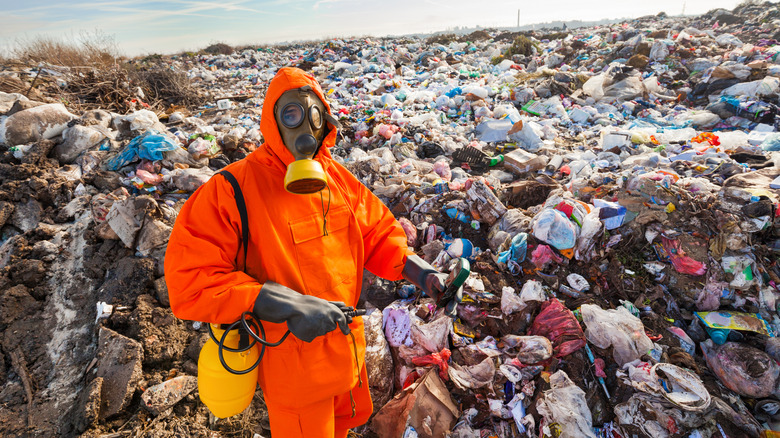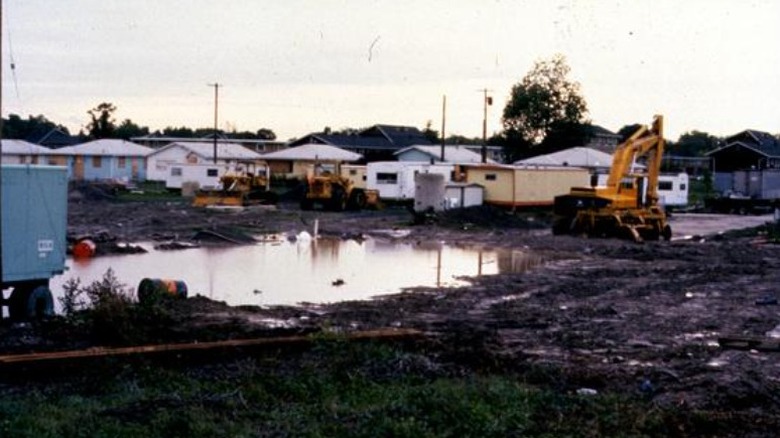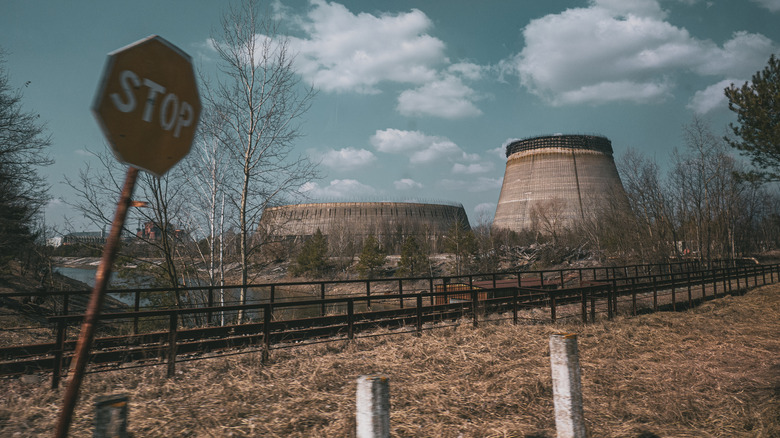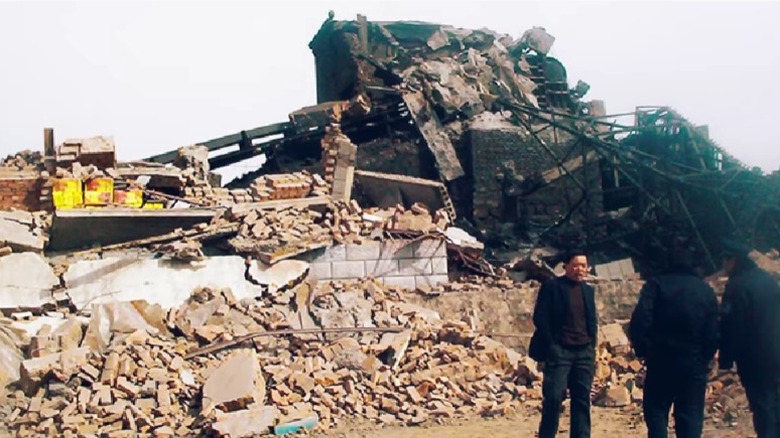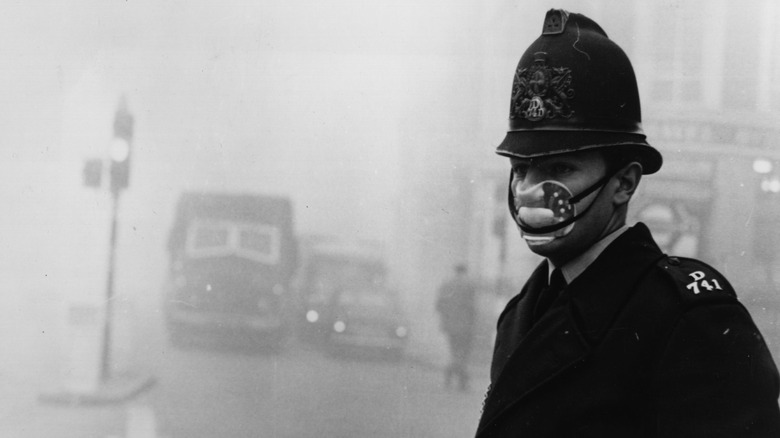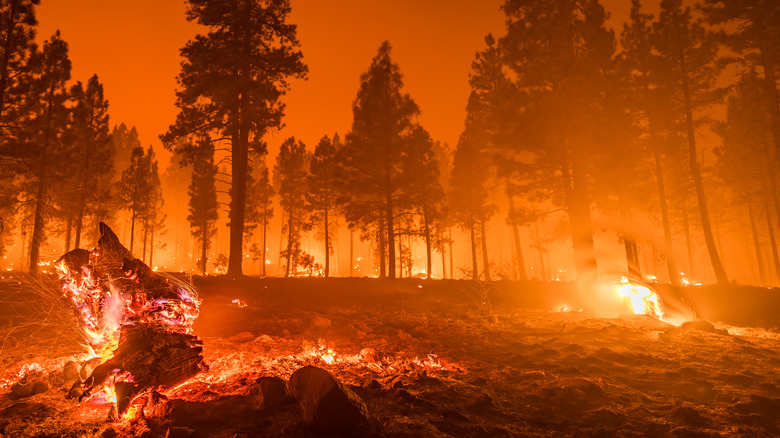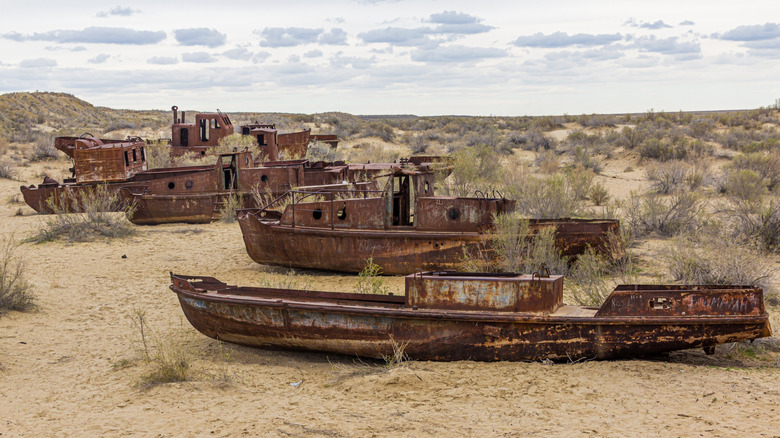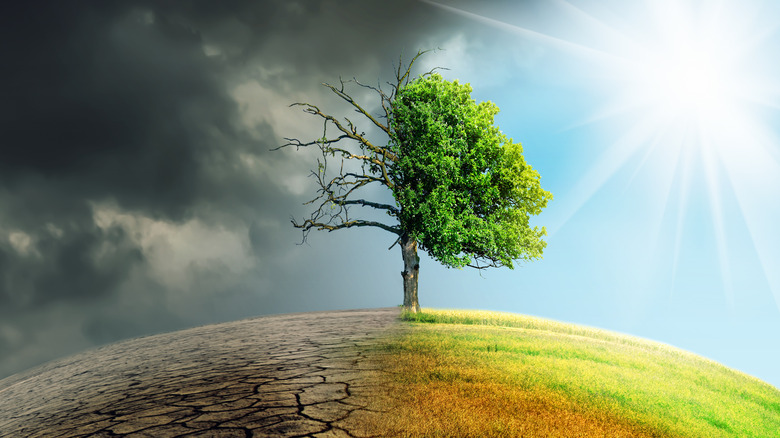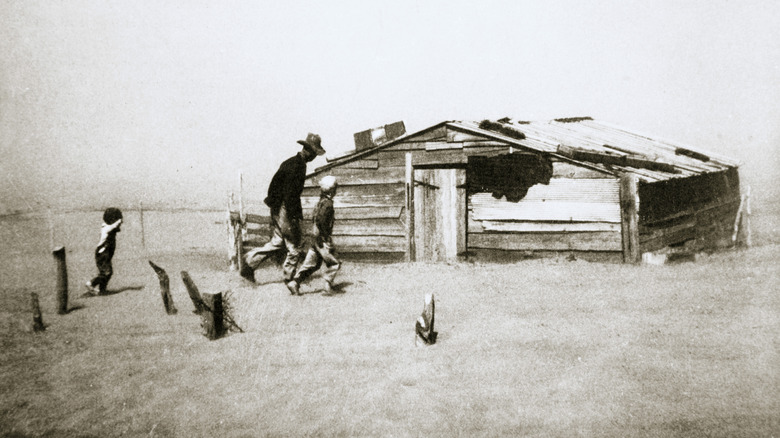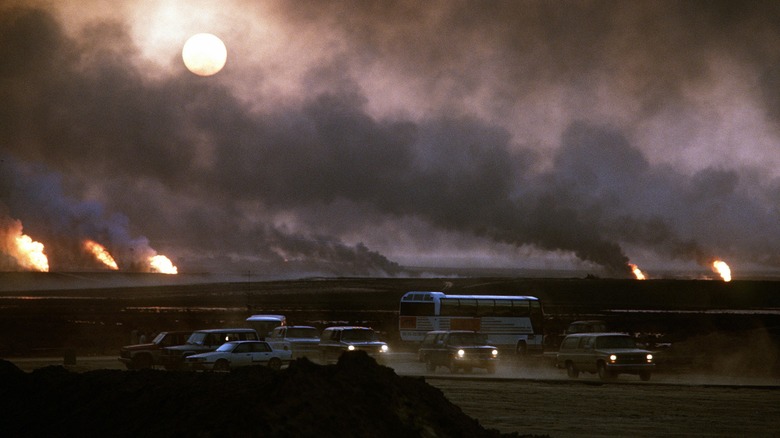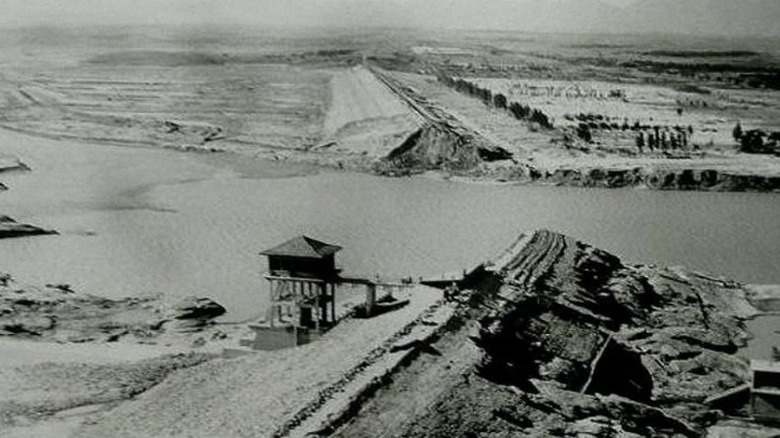The World's Worst Man-Made Disasters
It is one thing when a natural disaster hits — a hurricane, an earthquake, a volcano. Such events cannot be prevented. However catastrophic such events are, there is a grim acceptance that little could be done, or that everything that could be done was. But when death and destruction rain down because of a stupid mistake, or in the quest to make a quick buck, or to win a war, the viewpoint shifts. Acceptance turns to rage.
Man-made disasters are a bitter betrayal. The very term suggests that not only are they artificially generated, but that life and limb could have been spared with a little forward-thinking. But very often, they reveal the very worst of our species, with the only silver lining being that lessons were (perhaps) learned and history will (hopefully) not repeat.
And yes, people have indeed learned from their mistakes. Laws changed, standards reset, and precautions taken. We reassess. The world is made a better place, safer, more stable (or so we tell ourselves). But there is always the lingering, and very human, question following any man-made disaster: Did this have to happen? Here are some of the world's worst man-made disasters.
Love Canal
While the tragedy of Love Canal broke in 1978, it started in 1890. According to EPA transcripts, the New York location was envisioned as a planned community whose highlight was a hydroelectric canal linking the upper and lower Niagara rivers. However, the funding dried up with the canal only partially dug. Officials appropriated the ditch as a garbage dump — unsightly, but innocuous.
It was in the 1940s, when the Hooker Chemical Company bought the dump, that things went sideways. SUNY Geneseo recounts that Hooker buried 21,000 tons of toxins in barrels at the canal. The EPA continues, saying Hooker then sold the property to the city of Niagara Falls ... which then built houses on it.
For the next 20 years, the bomb ticked. Then a series of wet winters in the late 1970s made the chemical drums in the ground leach out and even rise to the surface — BOOM! As the EPA report tells, vegetation died en masse, children playing outside suffered chemical burns, and basements turned into noxious cauldrons.
Evacuations commenced, but birth defects and cancer plagued Love Canal residents for the rest of their lives. And Love Canal remains — the Buffalo News tells the now-maintained and monitored site is a bucolic grassland but adds the "deadliest toxins ever created" lurk just 18 inches underground.
Chernobyl
What happened at Chernobyl is incredibly complex, but the World Nuclear Association reduces the disaster down to a nuclear reactor with massive design flaws that was destabilized by a test conducted by inadequately trained personnel. The result was the worst nuclear accident in history, as Live Science notes.
According to the WNA, in April of 1986, Chernobyl Reactor No. 4 in the Soviet Union (now Ukraine) was powered down to test if the turbines, spun by residual steam, would continue supplying power. However, the reactor type at Chernobyl suffered from extreme sensitivity to excess steam causing reactivity to increase, a situation the engineers faced. To reassert control, engineers played around with the control rods, which were tipped with graphite, a material that accelerates nuclear reactions. The already unstable reactor went haywire, wedging the graphite in place and creating a massive power surge. This caused the core to explode, spewing a radioactive cloud all over Europe.
The death toll of Chernobyl is debated. The International Atomic Energy Association counted 28 fatalities within the first three months; the BBC tallied 31 as an immediate result. The U.N. later claimed that some 4,000 people would eventually die from radiation-related cancer. Cancer and radiation are surreptitious killers, taking years to emerge. Slate surmises the exact number of Chernobyl deaths will never be known.
A 1,550 square-mile Exclusion Zone was created around the most irradiated areas. As a final note, when Russia invaded Ukraine in February, 2022, radioactivity was observed to rise.
Benxihu Colliery Disaster
Mining has always been dangerous. Tunnels collapse or flood, gas build-up causes explosions or suffocation, and extreme temperatures risk health, as engineering experts Howden detail. Some of the oldest corpses ever found were from mines, according to World History Encyclopedia. But Benxihu stands out, not only as the worst mining accident on record, but how a bad situation can be made worse by sheer human heartlessness.
According to Britannica, in 1942, Benxihu was a Chinese coal mine under the supervision of the Imperial Japanese during World War II. And when an explosion rocked the complex, tragedy happened.
Coal mine fires are notoriously difficult to extinguish even in modern times. In 1942, with no safety infrastructure installed, the Imperial Japanese controllers sealed the shaft, reports the Australian Mine Safety Journal; cutting off the oxygen to extinguish the fire was a logical safety procedure. What was illogical was that miners were still in the shaft.
The Australian Mine Safety Journal goes on to reveal that 1,549 workers died by suffocation or carbon monoxide poisoning, not the fire. Authorities covered up the deaths; it was only in a later investigation that the scope of the Benxihu Colliery Disaster came to light.
The Great Smog of London
In the winter of 1952, southeast Britain experienced a quirk in the weather: According to records at the British Met Office, the winds stilled and a high-pressure blob of cold air lodged over the region with a "lid" of warm capping it. Called an anticyclone, this is a perfectly normal meteorological event. The problem was that it centered directly over London.
Terrible weather is no stranger to the United Kingdom, but that December was especially bitter. As the Met Office continues, Londoners did the natural thing and took to burning huge amounts of coal to heat their homes. But because of the anticyclone, the resulting smoke neither rose nor dispersed. Rather, it accumulated. That's when things got bad.
For five days, the British capital was locked in a 30-mile-wide smog so dense people could not see their feet and so lethal that 4,000 people died, with later estimates pushed to 12,000. According to History, cows choked in the fields, above-ground transportation was hamstrung, and scores of birds were killed.
Politicians did react to the Great Smog of London, however. The British government passed the Clean Air Act of 1956, and homeowners moved away from coal as a heating source. But to this day, a nickname for London is "the Smoke."
The Great Peshtigo Fire
If the Great Peshtigo Fire sounds new, it is probably because the spotlight is hogged by another, more metropolitan event that happened on the same day: the Great Chicago Fire. And while the Chicago conflagration was certainly devastating, Peshtigo was bigger, deadlier, and more expensive. This is simply a case of historians being selective.
The National Weather Service describes how summer of 1871 was particularly dry for the Green Bay area of Wisconsin. Survivors reported that railroad workers, using fire to clear brush, quickly lost control of the flames. What happened next was astonishing not only in scale, but in time.
In just two hours, what had been a controlled burn exploded across the landscape in what one survivor said was "like a tornado," destroying everything in its path. According to the Wisconsin Historical Society, an area of forest 10-miles wide and 40-miles long ignited, scorching some 1.5 million acres on both sides of Green Bay. Sixteen towns were reduced to ash, and at least 1,500 lost their lives (possibly up to 2,000) with another 1,500 injured. The National Weather Service recounts the heat was so great that fleeing victims spontaneously combusted. Those who survived did so only by seeking shelter in swamps and rivers. It was the worst forest fire in American history.
Aral Sea Disaster
Formed by the Syr Darya and Amu Darya rivers, the Aral Sea was something of a geological quirk. The USGS describes it as the fourth largest lake in the world (the BBC reckons 26,000 square miles), located in the middle of the bone-dry Central Asian deserts. As National Geographic relates, the sea and its rivers were the cradle of empires and a watery respite on the Silk Road. Then came cotton.
In 1959, the Aral Sea watershed, then controlled by the USSR, became, as described by a 1999 United Nations report, the site of a massive cotton-growing scheme, with waters diverted from the Syr Darya and Amu Darya. It worked; by 1980, Soviet Central Asia was producing a whopping 9 million tons of cotton. However, so much water was taken from the rivers that the Aral Sea could not be sustained. As NASA photos show, it dried up.
The U.N. called it "the most staggering disaster of the twentieth century." The Aral receded, turned saline, then toxic. The fishing industry was destroyed. The desert moved in and the exposed lakebed, where salt, heavy metals, and pesticides accumulated for years, became the source of poisonous dust storms, as per NASA.
USAID estimates the Aral is a tenth of its original size, and even after the Soviet breakup, cotton production remains too profitable among the various new nations for restoration to be considered.
Climate Change
Whine all you want, but climate change is happening. Here's the science (via the European Commission): Earth's industry is overwhelmingly powered by burning fossil fuels. Combustion of these fuels releases gasses, carbon dioxide in particular, that trap incoming heat from the Sun. This causes the planet's temperature to rise; NOAA monitoring indicates Earth warmed by 0.14 degrees every decade since 1880. The organization estimates levels of carbon dioxide alone are higher now than in the last 800,000 years, with amounts presently equal to those of three million years ago, when Earth experienced one of its warmest periods on record.
As Smithsonian Magazine relates, if Earth's atmosphere is an engine, heat is the gasoline. With global warming, hot places get hotter, wet places get wetter, storms and droughts intensify, and most profoundly, glaciers — from the Himalayas to the poles — melt. According to NASA, all that water eventually enters the oceans, which rise.
Bloomberg lists the inevitabilities on land and sea, from a food crop loss of $128 billion to a 99% coral death. Reports are already surfacing about what nations face when their territories are submerged.
But climate change is a disaster only now starting. It can be mitigated. Humanity has the technology; the EPA even has a helpful list. The question is if we have the will.
Bhopal
As Britannica relates, the world's worst industrial accident occurred in 1984 when a chemical leak at the Union Carbide pesticide plant in Bhopal, India, released a 45-ton witch's brew of lethal methyl isocyanate and other toxic gasses into the surrounding community. Heavier than air, the deadly cloud crept along the ground, killing up to 20,000 in its aftermath, including over time from related conditions. Britannica continues by saying blindness, birth defects, and respiratory ailments plagued the half-million survivors up to the present.
The Guardian picks up the story, suggesting the entire situation smacks of a conspiracy after the fact: Studies of the event or its repercussions among the populace are suppressed, no clean-up protocol was ever instigated, and the Indian government refused offers from the U.N. and Germany to test the local environment. The article also accuses American authorities of obstructing justice in order to protect economic interests with Union Carbide (now part of the Dow Chemical Company).
Time has not healed; according to The Atlantic "tons" of hazardous material lingers on at the site, persists in groundwater, and that for all the deaths and injuries, only seven Union Carbide employees were ever convicted (Britannica adds those convictions, found only in 2010, were of native Indian workers, not of the foreign overseers of the plant).
Perhaps the biggest tragedy of Bhopal was that nobody seemed to care.
The Dust Bowl
The Dust Bowl is one of the biggest disasters in American history but also represents a perfect storm of unrelated events. A study in journal Population and Environment recounts that in the early 1900s, overgrazing reduced vegetation to nubs, and farmers plowed their fields with no regard to what was already an arid climate. Combined, this left the soil exhausted and bare. As a Columbia University climatological review finds, the region was primed for wind erosion.
In 1930, the final blow struck. History tells that a series of severe back-to-back droughts hit the Great Plains. The poor land management lasting for years prior left the soil so fragile that ordinary winds gave rise to massive dust storms. The worst hit in 1935 when, as Weather.gov tells, a dust storm that began in Oklahoma morphed to "Black Sunday," a storm so dense it blotted out the Sun and reached as far as Idaho. History estimates the Dust Bowl lasted for 10 years, and, according to Britannica, 1.2 billion tons of soil was lost.
The Dust Bowl also offers an early example of massive population shift due to environmental stresses (the Great Depression didn't help). PBS estimates that by 1940, 2.5 million environmental refugees moved out of the Great Plains. Oklahoma alone experienced a 40% drop in population.
Kuwaiti Oil Fires
It was the final days of the Gulf War in January of 1991. Seeing defeat, forces under Saddam Hussein abandoned their occupation of Kuwait and pulled back into Iraqi territory. But this was no simple withdrawal; in a final "screw you" to allied forces led by the United States, Business Insider tells how the Iraqis launched a "scorched-earth policy" and opened up the oil wells and pipelines in northern Kuwait, setting many on fire.
Live Science estimates between 1,360,000 to 1,500,000 tons of oil was released into the Persian Gulf, creating a slick 101 miles by 42 miles and 5-inches thick. But more than just a man-made environmental disaster, the Kuwaiti Oil Fires also represent a man-made biological one; doctors at John Hopkins surmise the oil and its fumes were a contributing factor of Gulf War syndrome, a host of mysterious ailments lasting years after the war.
As catastrophes go, this one was born of pure malice. Stanford University calls the Kuwaiti Oil Fires "one of the largest acts of ecological terrorism the world has ever seen." Business Insider estimates 700 wells were destroyed, and noxious smoke plumes stretched almost 1,000 miles.
"Clean-up" is subjective; Stanford University notes most work was completed that July, but a 2011 Reuters news brief announced Kuwait was still actively engaged in the endeavor.
Banqiao Dam Failure
In 1975, Typhoon Nina hit China. Stalling over Henan Province, the storm dumped over 64 inches of rain in five days, according to the U.S. Department of Energy. That was the beginning of the disaster.
According to journalist Laura Smith writing for Timeline, the Banqiao Dam was built in 1952 to control the Ru River. While the official line was that Banqiao was "unbreakable," cracks in the dam appeared after its construction. The U.S. Department of the Interior states that the Banqiao reservoir had a capacity of 399,000 acre feet, with another 304,000 reserved for flood storage.
Because the typhoon had already flooded the region, Timeline recounts dam workers were ordered not to release water from Banqiao, even though water was cresting the dam. Panicked, the workers piled sandbags to add height, a procedure called overtopping. This increased reservoir capacity but put more pressure on the already unsound dam. It broke.
What happened next was the worst structural failure in history. The Department of Energy estimates a wave 26-feet high roared out of Banqiao, setting off a domino line of dam failures downriver. Timeline counts 26,000 drowned, with another 204,000 dying from water-borne diseases and starvation.
Agent Orange
To thwart the jungle warfare the Viet Cong had perfected against American forces in the Vietnam War, the U.S. decided to get rid of the jungle.
As detailed in a 1982 study by the Office of Air Force History, Operation Ranch Hand began in 1961 and was a 10-year program of mass aerial herbicide spraying across combat zones. According to History, one of these chemicals was Agent Orange. It was highly used, highly effective, and highly toxic. Containing dioxin, a substance the EPA designates as not only carcinogenic but incredibly persistent and able to remain in an environment for years, Agent Orange was rained down on Southeast Asian forests and combatants, friend and foe alike.
To the American and South Vietnamese governments, ecocide was just one more wartime tactic. But to quote History, returning veterans suffered "skin irritations, miscarriages, psychological symptoms, type 2 diabetes, birth defects in children, and cancers." A 1979 lawsuit determined that 2.4 million U.S. servicemen and women suffered toxic exposure to what Forbes estimates was 20 million gallons of Agent Orange used in the war.
In Southeast Asia, the BBC determined 3 million people suffered the effects of Agent Orange, with 400,000 dying. Birth defects continue among those exposed, and one source details that sprayed areas remain defoliated.
